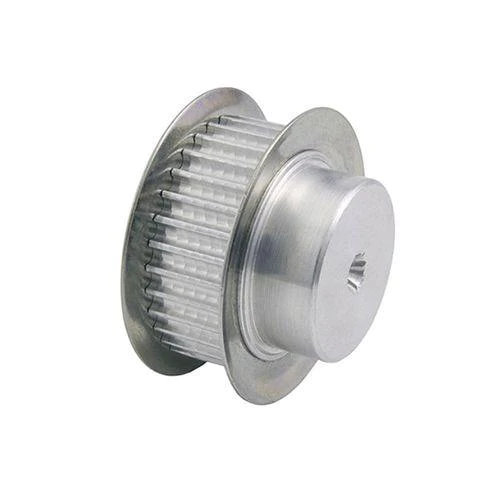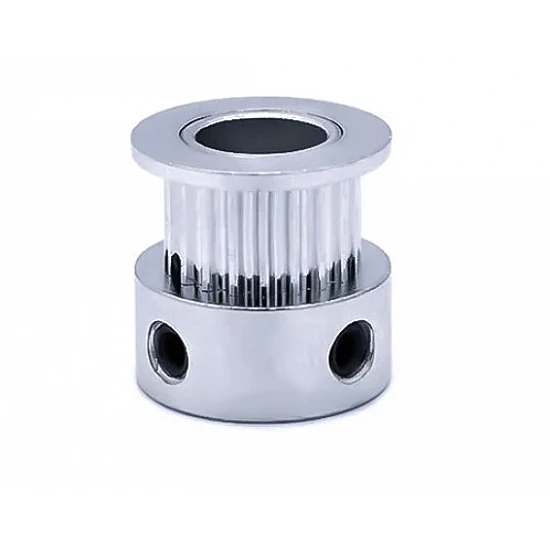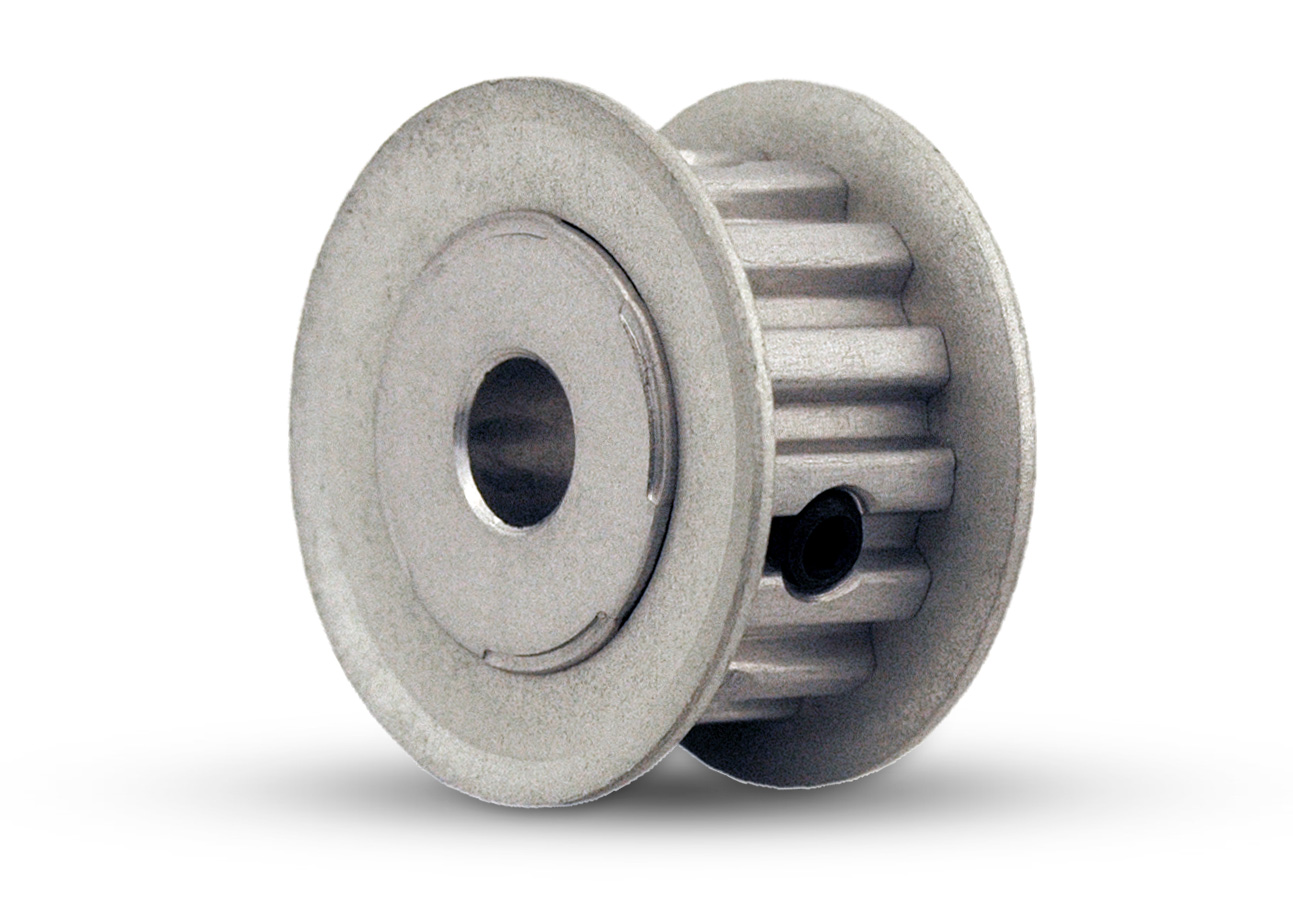Product Description
Type Mxl XL L H Steel Standard Bore Timing Pulley For Automation Industry
Synchronous belt pulley transmission is composed of an annular belt with equidistant teeth on the inner peripheral surface and a belt pulley with corresponding teeth. During operation, the belt teeth mesh with the tooth slots of the belt pulley to transmit motion and power. It is a new belt transmission that integrates the respective advantages of belt transmission, chain transmission and gear transmission.
Product Parameters
| Product | standard timing belt pulley & idler pulley |
| Customized | OEM, drawings or samples customized |
| Teeth type | Normal Torque Drive Type:MXL,XL,L,H,XH,XXH High Torque Drive Type:S2M,S3M,S5M,S8M,HTD2M,HTD3M,HTD5M,HTD8M,P2M,P3M,P5M,P8M High Precision Position Drive Type:2GT,3GT,5GT,8YU Light Load Drive Type:T5,T10,T20 Heavy Load Drive Type:AT5,AT10,AT20 |
| Basic shape | Type A,Type B,Type D,Type E,Type F,Type K |
| Adaption | Adapt to 1/4 inch,5/16 inch,1/2 inch, 3/8inch, 2/25inch, 1/5inch belt |
| surface treatment | Natural color anodizing,Black anodizing,Hard anodizing,Ni-plating,Blackening |
| Material | 6061(aluminum),S45C(45# steel),SUS304(Stainless steel) |
| Bore | Pilot bore, Taper bore and Customized bore. |
| Tolerance Control | Outer diameter ±0.005mm Length dimension ±0.05mm |
| Standard | DIN, ISO/GB, AGMA, JIS |
| Teeth Accuracy | DIN Class 4, ISO/GB Classs 4, AGMA Class 13, JIS Class 0 |
| Weight | Max 15Tons |
| testing equipment | projecting apparatus,salt spray test,durometer,and coating thickness tester,2D projector |
| producing equipment | CNC machine,automatic lathe machine,stamping machine,CNC milling machine,rolling machine,lasering,tag grinding machine etc. |
| Machining Process | Gear Hobbing, Gear Milling, Gear Shaping, Gear Broaching,Gear Shaving, Gear Grinding and Gear Lapping |
| Application industry | Robot industry,Medical industry,Making machine industry,Automation industry,3C industry equipment,Packaging industry,UAV industry,New energy industry. |
Company Profile
Hefa group adheres to the German precision transmission design and manufacturing technology, and has more than 20 years of experience in the gear manufacturing field. The 4 companies have more than 40000 square CHINAMFG of standard plants, more than 600 professional technicians, more than 500 sets of precision equipment and 19 related technical patents, forming a complete production, sales and service integration system. The company passed ISO9000 quality management system certification in 2009.
Packaging & Shipping
1. Lead time: 10-15 working days as usual, 30 days in busy season, it will based on the detailed order quantity;
2. Delivery of samples: by DHL, Fedex, UPS, TNT, EMS
FAQ
| Main markets | Southeast Asia, North America, Eastern Europe, Mid-East, West Europe |
| How to order | *You send us drawing or sample |
| *We carry through project assessment | |
| *We give you our design for your confirmation | |
| *We make the sample and send it to you after you confirmed our design | |
| *You confirm the sample then place an order and pay us 30% deposit | |
| *We start producing | |
| *When the goods is done,you pay us the balance after you confirmed pictures or tracking numbers | |
| *Trade is done,thank you!! |
/* January 22, 2571 19:08:37 */!function(){function s(e,r){var a,o={};try{e&&e.split(“,”).forEach(function(e,t){e&&(a=e.match(/(.*?):(.*)$/))&&1
| Certification: | CE, ISO |
|---|---|
| Pulley Sizes: | Type A |
| Manufacturing Process: | Casting |
| Material: | Aluminium Alloy |
| Surface Treatment: | Polishing |
| Application: | Medical Machinery |
| Samples: |
US$ 10/Piece
1 Piece(Min.Order) | |
|---|
| Customization: |
Available
| Customized Request |
|---|

What is the impact of tooth pitch and belt compatibility on XL pulley performance?
The tooth pitch and belt compatibility play a significant role in the performance of XL pulleys. Here is a detailed explanation of their impact:
1. Tooth Pitch:
The tooth pitch refers to the distance between the center of one tooth to the center of the adjacent tooth on a pulley. In the case of XL pulleys, they are designed to match XL belts with a specific tooth pitch. The tooth pitch directly affects the pulley’s performance in several ways:
a. Transmission Accuracy:
A precise tooth pitch ensures accurate transmission of motion and power between the pulley and the belt. Any deviation in the tooth pitch can result in inconsistent power transmission, leading to reduced performance and potential system errors.
b. Synchronization:
In applications that require multiple pulleys working together, such as in timing belt systems, maintaining the correct tooth pitch is crucial for proper synchronization. The teeth of the pulleys and belts must mesh precisely to ensure synchronized movement and timing accuracy.
c. Torque Capacity:
The tooth pitch affects the pulley’s torque capacity. A smaller tooth pitch allows for more teeth to engage simultaneously, distributing the load over a greater number of teeth and increasing the torque capacity. XL pulleys with a smaller tooth pitch can handle higher torque loads compared to those with a larger tooth pitch.
2. Belt Compatibility:
The compatibility between the XL pulley and the belt used in the system is crucial for optimal performance. Consider the following aspects of belt compatibility:
a. Size and Dimensions:
The XL pulley and the belt should have compatible sizes and dimensions. This includes the width and length of the belt, as well as the number of teeth on the belt. Proper sizing ensures a secure fit, prevents slippage, and maximizes power transmission efficiency.
b. Tooth Profile:
The tooth profile of the belt should match the tooth profile of the XL pulley. In the case of XL pulleys, the teeth have a trapezoidal shape. Using a belt with a different tooth profile can lead to improper engagement, increased wear, and reduced performance.
c. Material and Construction:
The belt material and construction should be suitable for the intended application and operating conditions. Factors such as the belt’s tensile strength, flexibility, and resistance to wear and temperature influence its compatibility with the XL pulley. Choosing the right belt material ensures optimal performance and longevity.
d. Manufacturer Recommendations:
It is important to refer to the manufacturer’s recommendations and specifications for both the XL pulley and the belt. Manufacturers provide guidelines for selecting compatible belts based on the pulley’s design, tooth pitch, and intended application. Adhering to these recommendations ensures proper performance and avoids compatibility issues.
In summary, the tooth pitch and belt compatibility have a significant impact on the performance of XL pulleys. The tooth pitch influences transmission accuracy, synchronization, and torque capacity. Belt compatibility, including size, dimensions, tooth profile, material, and following manufacturer recommendations, ensures optimal performance and reliable operation of the XL pulley system.

How does the tooth profile of XL pulleys contribute to their performance?
The tooth profile of XL pulleys plays a crucial role in determining their performance in power transmission systems. Here’s a detailed explanation of how the tooth profile contributes to their performance:
1. Efficient Power Transmission:
The tooth profile of XL pulleys is designed to engage with the corresponding teeth on the timing belt. This positive engagement ensures efficient power transmission by minimizing slippage and maximizing the transfer of rotational motion. The tooth profile allows for a large contact area between the pulley and the belt, enabling effective torque transfer and minimizing energy losses.
2. Accurate and Repeatable Positioning:
The tooth profile of XL pulleys enables accurate and repeatable positioning in motion control systems. The teeth on the pulley mesh precisely with the teeth on the timing belt, providing precise angular displacement and positioning control. This tooth engagement allows for reliable and consistent positioning, making XL pulleys suitable for applications that require high positional accuracy, such as robotics and CNC machines.
3. Reduced Backlash:
The tooth profile of XL pulleys helps reduce backlash, which is the play or clearance between the teeth of the pulley and the belt. Backlash can introduce inaccuracies and vibrations in the power transmission system. The tooth profile of XL pulleys minimizes backlash by ensuring a close fit with the timing belt teeth, resulting in smoother operation, improved precision, and reduced mechanical vibrations.
4. Load Distribution:
The tooth profile of XL pulleys allows for effective load distribution along the width of the belt. As torque is transmitted from the pulley to the belt, the tooth profile ensures that the load is evenly distributed across the belt’s width. This load distribution helps prevent concentrated stress points and excessive wear on specific areas, leading to improved durability and longevity of the pulley and belt.
5. Noise Reduction:
XL pulleys with well-designed tooth profiles contribute to reduced noise levels during operation. The tooth engagement and smooth meshing between the pulley and the timing belt minimize vibration and noise generation. This advantage is particularly important in applications that require low noise levels, such as medical equipment, office machinery, and audiovisual systems.
Overall, the tooth profile of XL pulleys significantly impacts their performance by enabling efficient power transmission, precise positioning, reduced backlash, even load distribution, and noise reduction. Manufacturers carefully design the tooth profiles of XL pulleys to optimize these performance characteristics for various applications and operating conditions.

In which applications and industries are XL pulleys commonly used?
XL pulleys find extensive use in various applications and industries that require precise motion control and power transmission. Here are some common applications and industries where XL pulleys are commonly employed:
1. Robotics:
XL pulleys are utilized in robotic systems for precise positioning and movement control of robot arms, grippers, and other robotic components. They enable accurate and synchronized motion, allowing robots to perform complex tasks with precision.
2. CNC Machines:
CNC (Computer Numerical Control) machines, such as milling machines and lathes, rely on XL pulleys for precise control of spindle speed and tool positioning. The accurate motion provided by XL pulleys ensures high-quality machining and dimensional accuracy in CNC operations.
3. 3D Printers:
XL pulleys are commonly used in 3D printers to control the movement of the print head and the positioning of the build platform. The precise motion control facilitated by XL pulleys contributes to the accuracy and fine detail of the printed objects.
4. Automated Systems:
XL pulleys are employed in various automated systems, including conveyor systems, packaging machinery, assembly lines, and material handling equipment. These systems require synchronized and precise motion to ensure efficient and accurate operation.
5. Industrial Machinery:
In industrial settings, XL pulleys are used in a wide range of machinery, such as textile machines, printing presses, woodworking equipment, and industrial automation systems. They provide reliable power transmission and motion control in these demanding applications.
6. Automotive Industry:
XL pulleys are utilized in automotive applications, including engine timing systems, accessory drives, and power steering systems. The precise control and synchronization offered by XL pulleys contribute to efficient and reliable operation of these automotive components.
7. Medical Devices:
In the medical field, XL pulleys are found in equipment such as diagnostic machines, laboratory automation systems, and surgical instruments. They enable accurate movement and positioning, ensuring the precision required for medical procedures and diagnostics.
8. Aerospace and Defense:
XL pulleys are used in aerospace and defense applications, such as satellite positioning systems, guidance systems, and unmanned aerial vehicles (UAVs). The reliable motion control provided by XL pulleys is crucial for the accurate operation of these aerospace and defense systems.
9. Research and Development:
In research and development laboratories, XL pulleys are employed in experimental setups, prototyping systems, and testing equipment. Their precise motion control capabilities support the development and validation of new technologies and products.
In summary, XL pulleys are commonly used in applications and industries that require precise motion control and power transmission. Their versatility and reliability make them suitable for a wide range of applications, from robotics and CNC machines to 3D printers, automated systems, automotive components, medical devices, aerospace, and research and development.


editor by CX
2024-03-28
